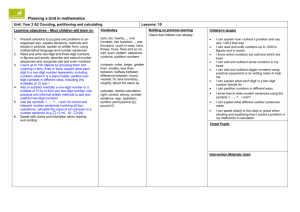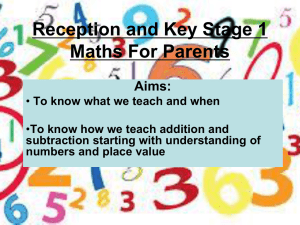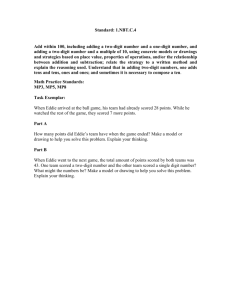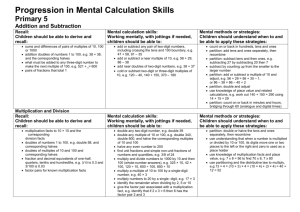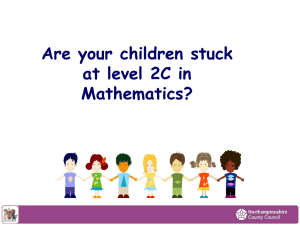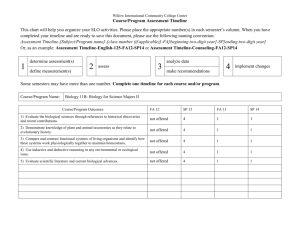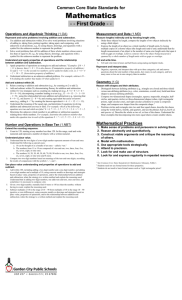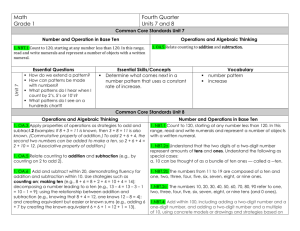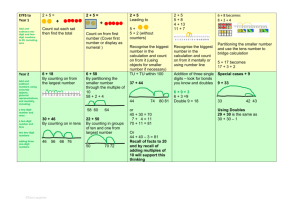Year_2_Block_A_Unit_1 - Buckinghamshire Grid for Learning
advertisement
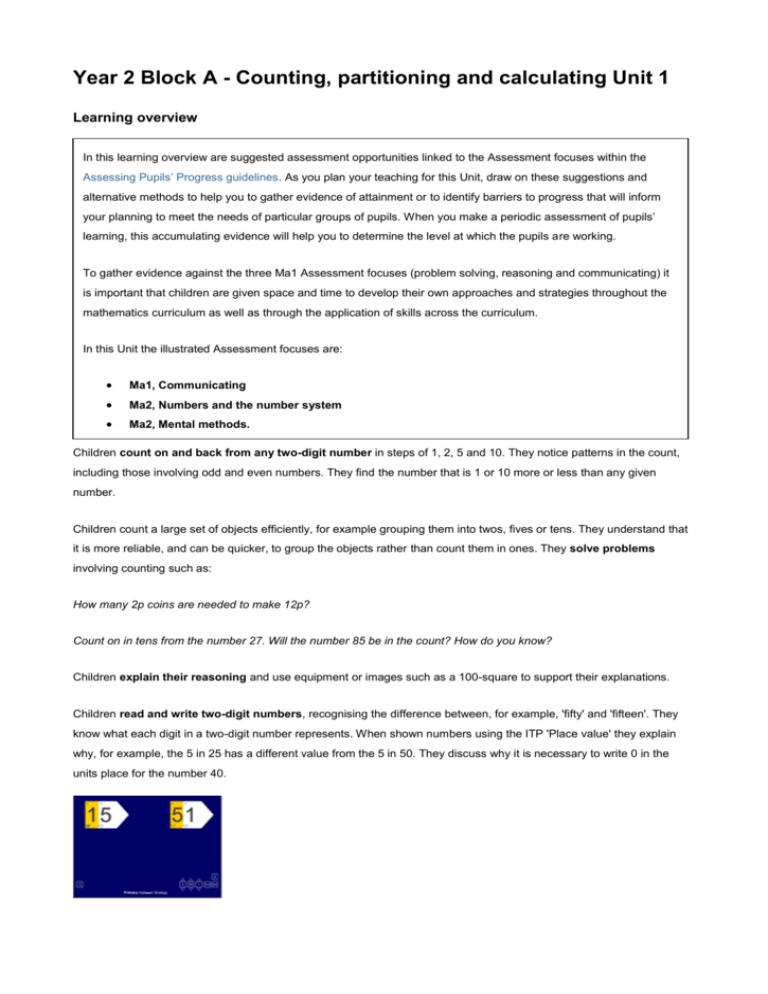
Year 2 Block A - Counting, partitioning and calculating Unit 1 Learning overview In this learning overview are suggested assessment opportunities linked to the Assessment focuses within the Assessing Pupils’ Progress guidelines. As you plan your teaching for this Unit, draw on these suggestions and alternative methods to help you to gather evidence of attainment or to identify barriers to progress that will inform your planning to meet the needs of particular groups of pupils. When you make a periodic assessment of pupils’ learning, this accumulating evidence will help you to determine the level at which the pupils are working. To gather evidence against the three Ma1 Assessment focuses (problem solving, reasoning and communicating) it is important that children are given space and time to develop their own approaches and strategies throughout the mathematics curriculum as well as through the application of skills across the curriculum. In this Unit the illustrated Assessment focuses are: Ma1, Communicating Ma2, Numbers and the number system Ma2, Mental methods. Children count on and back from any two-digit number in steps of 1, 2, 5 and 10. They notice patterns in the count, including those involving odd and even numbers. They find the number that is 1 or 10 more or less than any given number. Children count a large set of objects efficiently, for example grouping them into twos, fives or tens. They understand that it is more reliable, and can be quicker, to group the objects rather than count them in ones. They solve problems involving counting such as: How many 2p coins are needed to make 12p? Count on in tens from the number 27. Will the number 85 be in the count? How do you know? Children explain their reasoning and use equipment or images such as a 100-square to support their explanations. Children read and write two-digit numbers, recognising the difference between, for example, 'fifty' and 'fifteen'. They know what each digit in a two-digit number represents. When shown numbers using the ITP 'Place value' they explain why, for example, the 5 in 25 has a different value from the 5 in 50. They discuss why it is necessary to write 0 in the units place for the number 40. Children order numbers by discussing the value of their digits and by considering their relative positions on a number line. They know that when they order two-digit numbers the tens digit is more significant than the units digit. They use this to explain how to identify the larger or smaller of two numbers. They compare the size of two numbers and use the < and > symbols to record their comparison. Assessment focus: Ma2, Numbers and the number system Look for evidence of children using different models of the number system to represent and explain numbers. For example, look for children who know which numbers can be represented using just 10p coins or just rods of ten cubes and who relate this to counting in tens from 0 on a number line... As they order a set of two-digit numbers, notice if children need to refer to a line numbered from 0 to 100 to support their thinking or if they are beginning to use their knowledge of counting and saying number names in order to help them. Look for children considering the tens digit first, to put the numbers into order, and then considering the units digit if necessary. Children partition two-digit numbers and use this to solve problems. For example, they show that 53 = 50 + 3 or 40 + 13 or 30 + 23, and so on. They establish, for example, how many different numbers can be made with the place value cards 20, 40, 3 and 5. They record their solutions in an organised way using pictures or symbols. Children know which two-digit numbers are multiples of 10. They recognise which two multiples of 10 any two-digit number lies between. They use this to place two-digit numbers on a number line and to round numbers to the nearest 10 by considering which of the two multiples of 10 is closer. Assessment focus: Ma1, Communicating Look for evidence of how children represent their work. Look for children who use objects or pictures and those children who are beginning to use number sentences or record their work. Children add or subtract a one-digit number to or from any two-digit number by counting in ones, taking particular care when counting over a tens boundary. They begin to use their knowledge of number facts to 10 and partitioning to add and subtract numbers crossing the tens boundary, for example: 48 + 7 = 48 + 2 + 5 = 55 34 – 6 = 34 – 4 – 2 = 28 They demonstrate their calculations on a number line. Assessment focus: Ma2, Mental methods Look for the pairs of numbers that add to any number up to 10 that children know and can recall. Look for children using known facts and place value to add or subtract multiples of ten, e.g. using 2 + 5 = 7 to derive 20 + 50 = 70. Notice if children are beginning to use these addition facts when they add and subtract a one-digit number. For example, look for children knowing the distance from their start number to the appropriate tens boundary and then how many more to add or subtract. They explore what happens when, for example, you add 7 to any number and then subtract 7. They understand that addition and subtraction are inverse operations, i.e. that subtraction 'undoes' an addition and vice versa. They record related addition and subtraction sentences such as: 48 + 7 = 55 55 – 7 = 48 62 – 6 = 56 56 + 6 = 62 Children solve word problems using notes, number lines and number grids to support and explain methods. For example, given that a purse contains 54p, they explain how much money is left inside when 10p is taken out. They solve number puzzles such as: Put + or – in each circle to make these calculations correct: 27 8 = 35 62 55 = 7 38 2 5 = 41 They explain their methods and results using mathematical language, jottings and symbols. Objectives End-of-year expectations (key objectives) are emphasised and highlighted Children's learning outcomes are emphasised Assessment for learning Present solutions to puzzles and problems in an organised way; explain decisions, methods and results in pictorial, spoken or written form, using mathematical language and number sentences How did you solve the problem? How did you decide which information to use? How did you know which calculations to do? Explain how you did your calculation. Could you draw I can explain to others how I solved a problem something or use a number line to help us understand what you did? Read and write two-digit and three-digit numbers in figures and words; describe and extend number sequences and recognise odd and even numbers (Show number cards for 17 and 71.) Which of these numbers is seventeen? How do you know? What does the other one say? I can read and write two-digit numbers I know which numbers are odd and which are even Are these numbers even or odd? Count in fives from 0 up to 30. Which of those numbers are odd and which are even? How do you know? Count up to 100 objects by grouping them and counting in tens, fives or twos; explain what each digit in a two-digit number represents, including numbers where 0 is a place holder; partition two-digit numbers in different ways, including into multiples of 10 and 1 Tell me how many counters are in this pile. Can you find a quicker way than counting in ones? There are more than 20 counters here. Find out how many there are. Is there a better way than counting in twos? Why is this better than counting in ones or twos? I can count objects by putting them into groups I can partition numbers There are 4 tens in 40. How many tens are there in 47? What makes 40 and 47 different? Order two-digit numbers and position them on a number line; use the greater than (>) and less than (<) signs Look at these numbers: I can write numbers in order and position them on a number line I can use the greater than and less than symbols to show that one number is larger or smaller than another Which of the numbers lie between 30 and 40 on the 24 42 46 64 43 34 number line? Which of the numbers could you use to make this correct? < 24 Which of the numbers could you use to make this correct? > 43 Estimate a number of objects; round two-digit numbers to the nearest 10 Look at the counters in the pile/pencils in the pot. I can round numbers to the nearest 10 you make your estimate? What information did you use? Estimate how many counters/pencils there are. How did What helped you to decide? There are 26 counters in the pile/pencils in the pot. What is that rounded to the nearest 10? Add or subtract mentally a one-digit number or a multiple of 10 to or from any two-digit number; use practical and informal written methods to add and subtract two-digit numbers What is 37 + 8? What number facts might you use to help you work this out? How many do you need to add to 37 to get to the next multiple of 10? How might you partition 8 to help you? How could you show that on a I can add and subtract some numbers in my head number line? What is 37 – 8? Which number facts will help this time? How much do you need to subtract to go down to the multiple of 10 before 37? How much more do you need to subtract? Understand that subtraction is the inverse of addition and vice versa; use this to derive and record related addition and subtraction number sentences Look at this number sentence: 17 – 9 = 8 Write three more number sentences using these numbers. How do you know, without calculating, that I know that addition and subtraction 'undo' each other I can write three other related number sentences for 6+3=9 they are correct? Speak with clarity and intonation when reading and reciting Explain how you solved the problem. Does everyone I can speak clearly to the class or group when showing and explaining how I solved a problem or my method for a calculation I think of a number and add 5. The answer is 12. What is my number? understand how the problem was solved? Is there another way to explain? Would it help to use a diagram or use some practical equipment to show your solution?
